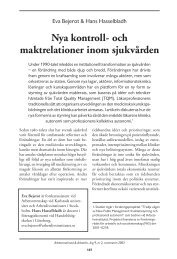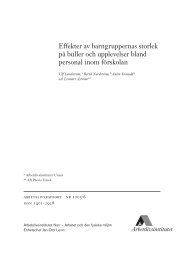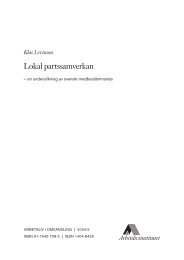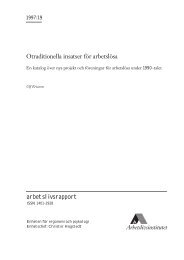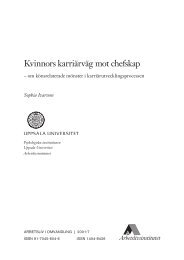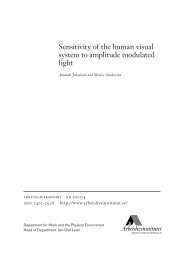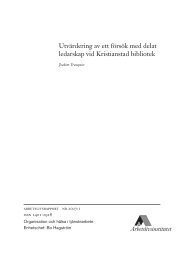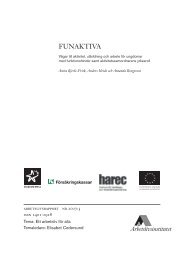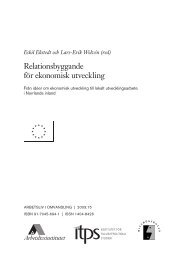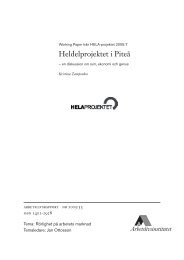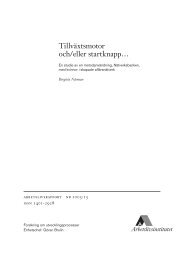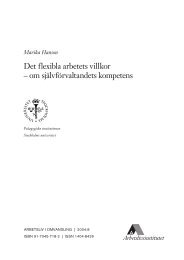Inventory of Tools for Ergonomic Evaluation - Ryerson University
Inventory of Tools for Ergonomic Evaluation - Ryerson University
Inventory of Tools for Ergonomic Evaluation - Ryerson University
Create successful ePaper yourself
Turn your PDF publications into a flip-book with our unique Google optimized e-Paper software.
<strong>Inventory</strong> <strong>of</strong> <strong>Tools</strong><strong>for</strong> <strong>Ergonomic</strong> <strong>Evaluation</strong>Patrick Neumannarbetslivsrapport nr 2006:21issn 1401-2928Research programme: Strategies and Methods<strong>for</strong> Management <strong>of</strong> the Work EnvironmentHead <strong>of</strong> programme: Marita Christmansson
BakgrundFöreliggande rapport är en sammanställning av utvärderingsmetoder inom arbetsmiljöområdetoch ingår som ett delarbete i tema Strategier, metoder och arbetssätt för fungerandearbetsmiljöarbete (SMARTA).SMARTA ingår i Arbetslivsinstitutets temaverksamhet. Under perioden 2004–2009 samlas<strong>for</strong>skare från Arbetslivsinstitutet och andra organisationer för att genomföra aktiviteter för ettbättre fungerande arbetsmiljöarbete.SMARTA ska bidra till ett hållbart arbetsliv där arbetsmiljöarbetet är en resurs för bådearbetsplatsen och individen. För arbetsplatsen kan det handla om konkurrenskraft, lönsamhetsamt attraktivitet och för individen om hälsa, välbefinnande, kreativitet och förnyelseförmåga.SMARTA tar ett helhetsgrepp på arbetsmiljöarbete inom olika regioner och branscher. Irapporter från SMARTA sammanställs kunskapsläget och exempel ges på arbetssätt som visatsig fungera för olika verksamheter med deras specifika förutsättningar och villkor.SMARTA ska besvara frågor som:• Hur kan arbetsmiljöarbete bedrivas?• Hur kan arbetsmiljöarbete integreras i organisationers kärnverksamhet?• Hur kan interna och externa aktörer agera för att få till stånd ett hållbart och fungerandearbetsmiljöarbete?SMARTA kännetecknas av en nära samverkan med företag, organisationer ocharbetsmiljöarbetets aktörer på det lokala, regionala och nationella planet. Lärande ochförändringsprocesser är centrala begrepp.Rapporten vänder sig till praktiker, konsulter och <strong>for</strong>skare som söker en metod för att mäta,utvärdera eller ut<strong>for</strong>ma arbetsmiljön med stöd av, till exempel, systematiskt arbetsmiljöarbete.Metoderna i denna sammanställning har hittats genom websökningar, litteratursökningar ochgenom kontakter bland <strong>for</strong>skare och praktikernätverk. Metoderna är grupperade enligt vad demäter eller var i utvecklingsprocesserna de passar. I största möjliga utsträckning finnslitteraturreferenser och web-länkar till verktygen. Vidare finns länkar till sidor med ytterligarein<strong>for</strong>mation om strategier och metoder kring utvärdering av arbetsmiljöarbete. Konceptetbakom rapporten är att presentera flera möjliga verktyg, och in<strong>for</strong>mationskällor, för att hjälpaläsaren att hitta en utvärderingsmetod som är anpassad till de egna behoven.Patrick Neumann, Ph.D., Eur.Erg.och SMARTA B2 Effektgruppen2
BackgroundThe following report is a summary, or ‘<strong>Inventory</strong>’, <strong>of</strong> tools <strong>for</strong> evaluating workingenvironment and is a part-project in the SMARTA research programme (‘Strategies andMethods <strong>for</strong> Management <strong>of</strong> the Working Environment’).SMARTA aims at contributing to a sustainable working life where work environmentimprovement ef<strong>for</strong>ts are a resource <strong>for</strong> both the workplace and the individual. Improvementscan lead to increased competitiveness and pr<strong>of</strong>itability <strong>for</strong> organizations and enhancecreativity, health and well being <strong>for</strong> individuals. During 2004-2009 researchers from NIWLand other organizations have come together to conduct activities <strong>for</strong> improving thefunctioning <strong>of</strong> work-environment improvement processes. SMARTA is funded by theSwedish National Institute <strong>for</strong> Working Life (NIWL).SMARTA takes a holistic view on work-environment work within different regions andbranches. Reports from SMARTA summarise available knowledge and provide examples <strong>of</strong>workplace practices that function well in different organisations with their specific conditionsand needs.SMARTA addresses questions such as:• How shall work-environment improvement ef<strong>for</strong>ts be conducted?• How can work-environment improvement ef<strong>for</strong>ts be integrated into organizationscore functions?• How can internal and external actors best support the management <strong>of</strong> workenvironments?SMARTA is characterised by a close cooperation with companies, organisations and workenvironmentactors at local, regional, and national levels. Learning and change processes arecentral concepts to SMARTA.This report is directed to practitioners and researchers who are looking <strong>for</strong> a method tomeasure work-environment in support <strong>of</strong>, <strong>for</strong> example, ergonomics improvement processes.Methods listed here have been identified by web and literature searches as well as throughcontacts in research and practitioner networks. The methods are grouped according to whatthey measure and where in the development process they can be applied. Where possiblethere are literature references and web-links to the tool itself. Furthermore in<strong>for</strong>mation andweb- links are provided to additional useful in<strong>for</strong>mation on strategies and methods <strong>for</strong>evaluating ergonomics situations. The concept behind the report is to present many possibletools, and in<strong>for</strong>mation sources, to help you find an evaluation method that is well suited toyour needs.Patrick Neumann, Ph.D., Eur.Erg.and the SMARTA B2 <strong>Evaluation</strong> Group3
Table <strong>of</strong> ContentsBAKGRUND...................................................................................................................................2BACKGROUND.............................................................................................................................3TABLE OF CONTENTS...............................................................................................................4INTRODUCTION..........................................................................................................................5METHODS......................................................................................................................................5RESULTS........................................................................................................................................5DISCUSSION..................................................................................................................................6CONCLUSIONS.............................................................................................................................7ACKNOWLEDGEMENTS...........................................................................................................7APPENDIX - INVENTORY OF TOOLS FOR ERGONOMIC EVALUATION...............81. TOOLS FOR STRATEGIC DECISION MAKING..............................................................82. TOOLS FOR WORK SYSTEM & PRODUCT DESIGN.....................................................8A. COMPLEX HUMAN SIMULATION MODELS.....................................................................8B. SIMPLER COMPUTERISED HUMAN BIOMECHANICAL MODELS..................................9C. DESIGN CHECKLISTS AND OTHER DESIGN TOOLS.......................................................9D. FLOW SIMULATION TOOLS.............................................................................................10E. TOOLS FOR PRODUCT DESIGN.......................................................................................103. INSTRUMENTS FOR EVALUATING WORK ENVIRONMENT...................................114. COMPUTER BASED EVALUATION TOOLS...................................................................125. CHECKLISTS FOR WORKPLACE EVALUATION........................................................136. QUESTIONNAIRES ON RISK FACTOR PERCEPTIONS..............................................15A. PHYSICAL RISK FACTORS..............................................................................................15B. PSYCHOSOCIAL & PSYCHOPHYSICAL..........................................................................157. QUESTIONNAIRES ON HEALTH & WELLBEING.......................................................16A. FATIGUE, MOTIVATION, SATISFACTION ETC................................................................16B. PAIN, DISABILITY & SYMPTOM SURVEYS.....................................................................168. ECONOMIC MODELS.........................................................................................................17OTHER SOURCES OF INFORMATION...............................................................................17DATABASES OF SCIENTIFIC JOURNALS...............................................................................18GOVERNMENTAL WEB SITES & INSTITUTES......................................................................18UNIVERSITY SITES.................................................................................................................19COMPANIES & OTHER............................................................................................................19REFERENCES............................................................................................................................194
IntroductionThis is an inventory <strong>of</strong> tools <strong>for</strong> description, evaluation, and design <strong>of</strong> workingenvironment / ergonomics. This ‘Tool <strong>Inventory</strong>’ is intended to assist practitioners inidentifying potentially useful methods <strong>for</strong> evaluating working environment in theirpr<strong>of</strong>essional work (or perhaps evaluating their own working environment!). The emphasishere is on tools that can be used to evaluate a workplace or a potential design <strong>for</strong> aworkplace, <strong>of</strong>ten in some kind <strong>of</strong> quantitative way. <strong>Evaluation</strong> methods and change tools suchas focus groups, photo-safari, or dialogue conferences are not included here. A number <strong>of</strong>such improvement tools are described in a related SMARTA project (Åteg et al., 2005). Thereare many evaluation tools ‘out there’ and this list includes only some <strong>of</strong> these.The aim <strong>of</strong> this report is to provide those seeking evaluation approaches with a broadoverview <strong>of</strong> available tools and connections to in<strong>for</strong>mation that can help choose the tool bestsuited to their needs.MethodsThe tools listed here were identified in a number <strong>of</strong> ways:• <strong>Tools</strong> and methods known to the author either directly or through reports &literature• <strong>Tools</strong> were identified in connection with the associated SMARTA evaluationreview project tools that had been used in the scientific studies <strong>of</strong> ergonomicsinterventions were included• <strong>Tools</strong> identified by web searches and from measurement text-books• <strong>Tools</strong> & tips provided by colleagues who viewed early versions <strong>of</strong> this listA classification scheme was developed as tool were collected based on characteristics <strong>of</strong> thetool and how the tool might be used. Whenever possible internet links and references areprovided giving the reader access to more in<strong>for</strong>mation and sometimes even copies or s<strong>of</strong>tware<strong>of</strong> the method itself. This scheme is sequenced roughly in order <strong>of</strong> stages <strong>of</strong> development.Thus simulation tools, that can be used be<strong>for</strong>e a workplace is built, are listed be<strong>for</strong>e checkliststhat usually require existing workplaces.ResultsThe main list <strong>of</strong> tools is presented in the Appendix (below).Tool were categorised as follows:1. <strong>Tools</strong> <strong>for</strong> Strategic Decision making2. <strong>Tools</strong> <strong>for</strong> Work System & Product DesignA. Complex Human Simulation ModelsB. Simpler Computerised Human Biomechanical ModelsC. Design Checklists and Other Design toolsD. Flow Simulation <strong>Tools</strong>E. <strong>Tools</strong> <strong>for</strong> Product Design5
3. Instruments <strong>for</strong> Evaluating Work Environment4. Computer Based <strong>Evaluation</strong> <strong>Tools</strong>5. Checklists <strong>for</strong> Workplace <strong>Evaluation</strong>6. Questionnaires on Risk Factor PerceptionsA. Physical Risk FactorsB. Psychosocial & Psychophysical7. Questionnaires on Health & WellbeingA. Fatigue, Motivation, Satisfaction etc.B. Pain, Disability & Symptom surveys8. Economic Models<strong>Tools</strong> <strong>for</strong> evaluating work environment were found in all categories except <strong>for</strong> the support <strong>of</strong>strategic decision-making. The most common tool identified was the ‘Checklist’ type tool,many <strong>of</strong> which exist in computerized <strong>for</strong>mats.DiscussionUse the right tool <strong>for</strong> the job. There is no ‘best’ tool. After all a hammer is not a ‘better’ toolthan a saw. The choice <strong>of</strong> tool depends there<strong>for</strong>e on what needs to be done. Early in a designphase it may be more suitable to use simulation approaches that can be based on early designspecifications. If a workplace is running, and a specific concern is to be addressed, then asimple paper and pencil tool may be more cost effective. When choosing a tool consider:What is the purpose <strong>of</strong> the evaluation? Who will gather the in<strong>for</strong>mation? Who will use or acton the in<strong>for</strong>mation? Just because you have a hammer in your hand doesn’t mean yourproblem is a nail.These tools aim to evaluate risk and consequences. Most <strong>of</strong> the tools listed here attempt toquantify the physical load or psychosocial conditions <strong>for</strong> the employee. Several tools areoriented to quantifying outcomes such as pain or disability. A few tools consist <strong>of</strong> economicmodels that try to evaluate a potential change in terms <strong>of</strong> productivity, costs, and financialbenefits.Every tool has a ‘blind spot’. No tool is perfect. Carpenters have dozens <strong>of</strong> tools <strong>for</strong>different tasks. Remember that there are <strong>of</strong>ten ‘intangible’ effects from change projects. It ishelpful to try and capture these with more qualitative approaches – by interviewing the peopleinvolved. This can provide insight into the effects (and process) <strong>of</strong> change that might not beclear from a particular tool. Operator and supervisor descriptions <strong>of</strong> how the system isworking and where improvements might be made can support and shed light on the results <strong>of</strong>your analysis.It’s the skill <strong>of</strong> the carpenter not just the sharpness <strong>of</strong> the saw that counts. Of course agood tool makes a big difference, but how the tool is used is also critical. The way you use atool and the process by which the in<strong>for</strong>mation is used by you and by others can always beimproved. Think <strong>of</strong> the tool as supporting your organisations continuing development ef<strong>for</strong>ts.This list is incomplete. New tools are being developed continuously and old tools maybecome obsolete, unavailable, or simply missing from this list! (please submit toolin<strong>for</strong>mation <strong>for</strong> inclusion in future inventory versions) Look around be<strong>for</strong>e choosing a tool. Itmay seem like extra ef<strong>for</strong>t but it can both save time and give better results in the long runmaking the early investment worthwhile. Use this list, and the links contained here, as a6
jumping <strong>of</strong>f point to your own search <strong>for</strong> tools that suit your needs and the needs <strong>of</strong> yourworkplace.ConclusionsThere are many tools available <strong>for</strong> evaluating ergonomics at different stages in thedevelopment process. Checklists (<strong>of</strong>ten implemented on computers) <strong>for</strong> evaluating currentworking situation appear to be the most common tool type. Research is needed to examine theextent to which tools are being used by practitioners, the process by which tools are used, andtheir experience <strong>of</strong> the benefits and drawbacks <strong>of</strong> various tools.AcknowledgementsThis work has been funded by the SMARTA theme <strong>of</strong> the Swedish National Institute <strong>for</strong>Working Life. Thanks go to the SMARTA ‘<strong>Evaluation</strong>’ Group including Jörgen Eklund, LarsLindbeck, Lena Karlqvist, and Bo Hansson.7
APPENDIX<strong>Inventory</strong> <strong>of</strong> <strong>Tools</strong> <strong>for</strong> <strong>Ergonomic</strong> <strong>Evaluation</strong>1. <strong>Tools</strong> <strong>for</strong> Strategic Decision makingWe are not aware <strong>of</strong> any tools available to help managers evaluate strategic alternatives inwork-environment terms. Nevertheless some tools do exist in this area such as workshops,focus groups and the like that are intended to provide a <strong>for</strong>um in which alternatives can bedeveloped and examined by a broad range <strong>of</strong> stakeholders with different perspectives on theissues involved (Jensen, 2002).This category remains part <strong>of</strong> this inventory to emphasise the importance strategic decisionmaking has <strong>for</strong> working environment (Neumann, 2004) and, conversely, the importance workenvironment can have <strong>for</strong> realising company strategy - the topic <strong>of</strong> another SMARTA project(Dul & Neumann, 2005; Neumann & Dul, 2005). Strategic choices frame all subsequentdecision making that ultimately affects ergonomics.Know a tool? submit suggestions to: pneumann@ryerson.ca2. <strong>Tools</strong> <strong>for</strong> Work System & Product Design<strong>Tools</strong> in this category are useful in the evaluation <strong>of</strong> workplaces in the design stage. Thesetools can also <strong>of</strong>ten be used to evaluate existing designs.A. Complex Human Simulation Models“Complex” computer models include higher-end products designed to allow 3D modelling <strong>of</strong>humans in a 3D environment such as CAD. For a complete discussion <strong>of</strong> the capabilities andutility <strong>of</strong> these tools check out works by Sundin <strong>for</strong> pracitioners and researchers (A. Sundin,2001; A. Sundin et al., 2004; A Sundin & Cyrén, 1998; A. Sundin & Sjöberg, 2004).i. Jack - see www.eds.com/products/plm/efactory/jack orwww.ugs.com/products/tecnomatix/human_per<strong>for</strong>mance/jackii. Ramsis - see www.ramsis.deiii. SAFEWORK - see www.safework.comiv. ENVISION/ERGO - see www.delmia.comv. eMHuman – see www.ugs.com/products/tecnomatix/human_per<strong>for</strong>mancevi. ERGOMan - see www.delmia.comvii. ManneQuinPRO – see www.nexgenergo.com/ergonomics/mqpro.html8
viii. IPME – see www.maad.com/index.pl/ipmeOther? submit to: pneumann@ryerson.caThese tools <strong>of</strong>ten contain various ergonomics assessment approaches such as reach and fitchecking, NIOSH equation, modified Checklist approaches, and biomechanical models todetermine physical loading and exposure to risk factors.B. Simpler Computerised Human Biomechanical ModelsThese models are generally less expensive and simpler to use. They may be 2 or 3dimensional and may even consider repeated or cumulative loading as part <strong>of</strong> the assessment.These are good tools both in design stages and also to quantify loading <strong>of</strong> existing systems tohelp identify areas <strong>for</strong> improvement and quantify the extent <strong>of</strong> load reduction in a particularsituation.i. 4D WATBAK – A simple model from the <strong>University</strong> <strong>of</strong> Waterloo that allowsmodelling <strong>of</strong> single work activites as well as calculating cumulative load over afull shift (hence the ‘fourth’, time, dimension). Both indicators have been riskcalibrated in epidemiological research (Neumann et al., 1999; Norman et al.,1998). (see www.ahs.uwaterloo.ca/~escs )ii. 3D SSPP - The <strong>University</strong> <strong>of</strong> Michigan’s famous 3D Static Strength PredictionProgram allows fast determination <strong>of</strong> 3D loads <strong>for</strong> specific work actions . (seewww.engin.umich.edu/dept/ioe/3DSSPP )iii. BakPak - <strong>University</strong> <strong>of</strong> Windsor model - predicts spinal loads based on reachlocation inputs. (contact: jpotvin@uwindsor.ca )Other? submit to: pneumann@ryerson.caC. Design Checklists and other Design <strong>Tools</strong>This includes ‘paper’ checklists or working concepts (which may even be implemented in acomputer system) that can support the evaluation and application <strong>of</strong> ergonomics factors inprocess design. These tools tend to operate at different stages <strong>of</strong> the design process but sharea common strength in that they have potential to connect to existing engineering tools andprocesses.i. Design <strong>for</strong> Assembly (DfA) - A generic concept that encourages productdesigners to consider how easy assembly will be. (see (Helander & Nagamachi,1992).ii. ErgoSAM - An ergonomic add-on <strong>for</strong> the Swedish SAM method <strong>for</strong> standardtime allocations (which is a common job planning tool, an MTM system).Provides red-yellow-green determination based on the engineer’s determination <strong>of</strong>task requirements (Laring et al., 2005; Laring et al., 2002).iii. ERGONOVA – <strong>Ergonomic</strong>s addition to the classic ‘value stream mapping’ tool<strong>for</strong> production system improvement (Jarebrant et al., 2004).9
iv. FMEA tools – Failure Mode Effect Analysis; a common risk analysis tool thathas been adapted to include ergonomics aspects in product and production processdevelopment (Munck-Ulfsfält, 2004).Other? submit to: pneumann@ryerson.caD. Flow Simulation <strong>Tools</strong>A number <strong>of</strong> different discrete event (flow) simulation tools exist on the market. These canbe used to assess human factors in terms <strong>of</strong> time utilised <strong>for</strong> different activities in the systemand can also be used to test how the system per<strong>for</strong>ms under different work organisationstrategies (Neumann & Medbo, 2005). Flow simulation can also be used in combination withhuman-biomechanical simulation (or other tools) to predict loading with differentconfigurations (Neumann & Kazmierczak, 2005). Many <strong>of</strong> these packages are made by thesame companies that make human modelling s<strong>of</strong>tware and/or other types <strong>of</strong> manufacturingin<strong>for</strong>mation systems (MIS).i. Simul8 – a simple graphically oriented package. (see www.simul8.com )ii. Delmia – see www.delmia.com .iii. Technomatix – see www.ugs.com/products/tecnomatix .iv. microSAINT – see www.maad.com/index.pl/micro_saint.Other? submit to: pneumann@ryerson.caFor a more complete list, and evaluation review, <strong>of</strong> available simulation packages see theexcellent simulation s<strong>of</strong>tware survey in the OR/MS journal <strong>of</strong> the Institute <strong>for</strong> OperationsResearch and Management Science (INFORMS ).E. <strong>Tools</strong> <strong>for</strong> Product DesignThere appear to be few tools oriented to the determination <strong>of</strong> ergonomics issues in the design<strong>of</strong> the product (although the human simulation s<strong>of</strong>tware listed above can be used in this way).A couple <strong>of</strong> texts do exist in this area though:Boothroyd, G., Dewhurst, P. And Knight, W., 2002, Product Design <strong>for</strong> Manufacture andAssembly (New York: Marcel Dekker).Helander, M. and Nagamachi, M. (1992) Design <strong>for</strong> Manufacturability: A systems approachto concurrent engineering and ergonomics, Taylor & Francis.i. Quality Function Deployment – an adaptation <strong>of</strong> a well known design tool tointegrate human factors considerations into early design stages (needs analysis) –provides an example <strong>of</strong> deboning knife design (Marsot, 2005). The method, basedon the ‘house <strong>of</strong> quality’ approach supports balanced consideration <strong>of</strong> varyingrequirements based on their priority and the extent the criteria is fulfilled by agiven design option.10
ii. Kansei Engineering – More an approach than a tool this method focuses ondesigning products according to the users´ feelings and impressions. (seewww.ikp.liu.se/kansei or (Nagamachi, 2002).Other? submit to: pneumann@ryerson.ca3. Instruments <strong>for</strong> Evaluating Work Environment<strong>Tools</strong> in this list are oriented towards the evaluation <strong>of</strong> individuals while at work. Thisincludes simple tools and sophisticated measuring equipment. A number <strong>of</strong> manufacturersare named here but these are not the only companies available. Contact your local equipmentsupplier – they’ll be happy to discuss your particular needs.i. Tape measure – a classic but useful tool <strong>for</strong> reach & fit measuresii. Stopwatch – time remains an important aspect <strong>of</strong> biomechanical exposuresiii. Force gauge – another classic tool; fish-hook type scales are cheapest but a pushpullgauge can be more versatile <strong>for</strong> measuring <strong>for</strong>ces other than lifting. Multiplemanufacturers exist – try your local retailer , or www.nexgenergo.com - acompany with many different <strong>for</strong>ce gauges and other tools.iv. Counter – A handheld counting tool that is helpful when counting repetition ratesor parts <strong>for</strong> estimating total loading (available at your hardware store).v. Data Loggers – Advanced data collection system <strong>for</strong> measuring EMG or posturewhile working (Hansson et al., 2003). Other companies also sell such equipment.vi. MEGA Electronics – A commercial system <strong>for</strong> measuring EMG or posture whileworking (www.meltd.fi ). Many other companies sell EMG equipment.vii. Lumbar Motion Monitor – A device <strong>for</strong> tracking back postures in 3dimensions atwork, development headed by Marras at Ohio State (Marras et al., 1995; Stanton etal., 2004).viii. SEIP - Synchronised Exposure and Image Presentation; A tool allowing thepresentation <strong>of</strong> video recordings and synchronised load/<strong>for</strong>ce/EMG measurementson a computer screen (Forsman et al., 1999). (contact: mikael.<strong>for</strong>sman@niwl.se )ix. Vibration & Sound meters – there are many on the market, make sure your toolcomplies to the latest standards that you wish to con<strong>for</strong>m to. This inventory willnot go into further details <strong>of</strong> available equipment.Other? submit to: pneumann@ryerson.ca11
xii. PEO – Portable <strong>Ergonomic</strong>s Observation method <strong>for</strong> computer supported fieldobservation, developed in Sweden (Fransson-Hall et al., 1995; Fransson-Hall etal., 1993). (see www.arbetslivsinstitutet.se )xiii. PostureProgram – A relatively simple video based approach, allowingquantification <strong>of</strong> trunk and arm postures and velocities during work (Neumann etal., 2001). (research prototype, now easily reproduced)xiv. VIDAR/PSIDAR – A video based system allowing employees to rate bothphysical (VIDAR) and psychosocial (PSIDAR) working environment at chosenpoints in time from the video (Johansson Hanse & Forsman, 2001; Kade<strong>for</strong>s &Forsman, 2000). (contact mikael.<strong>for</strong>sman@niwl.se)Other? submit to: pneumann@ryerson.ca5. Checklists <strong>for</strong> Workplace <strong>Evaluation</strong>Many checklist type tools exist both as paper <strong>for</strong>ms and sometimes implemented intocomputer programs. This list highlights a number <strong>of</strong> examples that are either well-known orprovide potentially useful opportunities <strong>for</strong> practitioners. It is quite common <strong>for</strong> practitionersto adopt a checklist <strong>for</strong> their own needs. It is worthwhile checking library databases (seeAppendix) <strong>for</strong> checklist tools that may have been adapted to your needs.i. ’Arbetplatsprovaren’ – A Swedish language, internet-based survey <strong>of</strong> physicaland psychosocial aspects <strong>of</strong> the workplace. (see www.tcodevelopment.com )ii. ‘Arbetsmiljön i skolan’ – A Swedish language checklist tool <strong>for</strong> improvingschool work environments. (see www.arbetslivsinstitutet.se )iii. Ergonomitermometer – A Swedish language tool using a ‘thermometer’metaphor to help assess risk levels. (see www.prevent.se - this site contains anumber <strong>of</strong> other ‘work environment’ checklists adapted to various sectors)iv. Ergonomiska Checklista Datorarbete – A simple checklist <strong>for</strong> evaluation <strong>of</strong>computer workplaces. (see www.amm.se/fhvmetodik )v. Keyserling checklist – A classic, simple, risk factor checklist easily adapted tousers needs (Keyserling et al., 1991).vi. MAC – The Manual Handling assessment Chart, like the NIOSH equiation thisallows easy assessment <strong>of</strong> MMH tasks. (see www.hse.gov.uk/msd/mac )vii. ManTRA – A checklist from the <strong>University</strong> <strong>of</strong> Queensland. (seehttp://ergonomics.uq.edu.au/index.html - available as download from the<strong>University</strong> <strong>of</strong> Queensland)viii. NIOSH equation – An approach to calculating a ‘maximum’ permissible load <strong>for</strong>different lifting circumstances. Exists in the original 1993 version and a newer‘revised version’ (T.R. Waters & Putz-Anderson, 1999; Thomas R. Waters et al.,1993). (see www.hse.gov.uk/msd , full description can be found also at the NIOSH13
web-site http://www.cdc.gov/niosh/94-110.html )ix. Psychophysical ratings – A rating made by someone <strong>of</strong> their own experience(‘psycho’) <strong>of</strong> loading (‘physical’). A versatile approach pioneered by Borg andbroadly applied in various contexts (Borg, 1990).x. Psychophysical tables – An outgrowth <strong>of</strong> psychophysical ratings, these tablesusually provide load or rate limits <strong>for</strong> material handling based on operators’perception <strong>of</strong> how much load they believe they can handle under varyingconditions <strong>of</strong> load, frequency, position etc.. Sometimes called ‘Snook’ tables afterthe innovator <strong>of</strong> this approach. A number <strong>of</strong> studies have been conducted bydifferent researchers to provide load limits under different circumstances (Dahalan& Fernandez, 1993; Potvin et al., 2000; Snook & Cirello, 1991). These tables aresometimes implemented in s<strong>of</strong>tware versions (e.g. Ergowatch).xi. PLIBEL - A 1-page checklist, mostly <strong>of</strong> physical risk factors, available inseveral different languages(Kemmlert, 1994, 1995), (Stanton et al., 2004).xii. REBA – Rapid Entire Body Assessment tool, similar to RULA but with a wholebody focus (Hignett & McAtamney, 2000) and also in (Stanton et al., 2004).(seehttp://ergo.human.cornell.edu/cutools.html or www.hse.gov.uk/msd )xiii. Risk Filter – Also from the UK Health & Safety Executive, this two stage toolfocuses on upper limb MSD risk. (see www.hse.gov.uk/msd/risk.htm )xiv. RULA – Rapid Upper Limb Assessment tool provides a ‘score’ <strong>for</strong> upper limbdemands by McAtamney and Corlett (McTamney & Corlett, 1994) see also(Stanton et al., 2004). (see http://ergo.human.cornell.edu/cutools.html orwww.hse.gov.uk/msd )xv. The Strain Index – Combines time, repetition, load, and posture into a singleindex focused on hand/wrist load (Moore & Garg, 1994) and see also (Stanton etal., 2004).xvi. QEC – The ‘Quick Exposure Checklist’ <strong>for</strong> assessing risk factors <strong>for</strong> work-relatedmusculoskeletal disorders (Stanton et al., 2004).(seehttp://www.sunderland.ac.uk/~ts0gli/QEC.html or www.hse.gov.uk/msd )xvii. OCRA – A ‘concise’, checklist based, index <strong>for</strong> assessing risk due to repetitivemovements (Occhipinti, 1998; Stanton et al., 2004) (Grieco, 1998).xviii. OWAS – The Ovako Working Posture Analysis System <strong>for</strong> rapid assessment <strong>of</strong>postural loads at work. (free s<strong>of</strong>tware available from www.turva1.me.tut.fi/owas )xix. WEST – Work Environment Survey Tool – provides both traditional ergonomicand occupational hygiene analysis possibilities. From the Swedish IndustrialResearch and Development Corp. (seewww.ivf.se/ivfTemplates/ProductDescription202.aspx )Other? submit to: pneumann@ryerson.ca14
6. Questionnaires on Risk Factor PerceptionsThese tools are intended to be used to survey groups <strong>of</strong> workers on their perception <strong>of</strong>physical and psychosocial work environment. It is common <strong>for</strong> these tools to have severalquestions on a particular factor that are then combined to generate a single index <strong>for</strong> thatfactor; so make sure you can get access to a guide that specifies how questions are to beprocessed once you get your questionnaires back!A. Physical Risk Factorsi. DMQ – The ‘Dutch Musculoskeletal Questionnaire’ from TNO (Hildebrandt etal., 2001; Stanton et al., 2004). (see www.workandhealth.org )ii. Nordic Safety Questionnaire – A questionnaire tool from Scandinavianresearchers with a Safety-culture focus (Kines et al., 2005). (contact:marianne.torner@niwl.se )iii. RFQ - Risk Factor Questionnaire a 25 item questionnaire with a focus on riskfactors <strong>for</strong> low back pain (Halpern et al., 2001).Other? submit to: pneumann@ryerson.caB. Psychosocial & Psychophysicali. CopSoq – The ‘Copenhagen Psychosocial Questionnaire’ developed by theDanish ‘Arbetsmiljöinstitutet’. The instrument includes 3 levels <strong>of</strong> detail <strong>for</strong>researchers, consultants, and companies. A brief description , and access to theEnglish version is available from AMI . (see www.ami.dk )ii. Job Content Instrument – perhaps the best-known psychosocial questionnaire.Based on the ‘Demand-Control’ model by Karasek and later extended to include a‘Support’ dimension (R. Karasek et al., 1998; R. Karasek & Theorell, 1990; R. A.Karasek, 1979).iii. PAK – ‘psykologisk arbetsmiljökartläggning’ a Swedish instrument <strong>for</strong>psychsocial work surveys (Rubenowitz, 1987, 1991).iv. Psykisk Arbejdsmiljø – A Danish tool <strong>for</strong> psychological work environmentevaluation, also from AMI , with long and short <strong>for</strong>ms available on the web. (seewww.ami.dk )v. QPS Nordic & QPS34+ – A 123 question (34 question short <strong>for</strong>m) instrument onstressors in the working environment. (see web brochure , http://hesa.etuirehs.org/uk/newsletter/files/2002-19p45-47.pd<strong>for</strong> Svensk in<strong>for</strong>mation ,http://ebib.arbetslivsinstitutet.se/arb/2000/arb2000_19.pdf)Other? submit to: pneumann@ryerson.ca15
7. Questionnaires on Health & WellbeingThe tools in this category all focus in the effect work has on the individual. This mightinclude health outcomes, pain surveys, stress and so <strong>for</strong>th. The distinction between these andthe psychosocial tools above is the change from the experience <strong>of</strong> the workplace to the effectsthat workplace has on the individual.A. Fatigue, Motivation, Satisfaction etc.i. SOFI – Swedish Occupational Fatigue <strong>Inventory</strong> provides a detailed reporting<strong>of</strong> employees perceived tiredness at the end <strong>of</strong> a working day (Elisabeth Åhsberg,1998; E. Åhsberg et al., 2000; Åsberg, 2000). (report available fromwww.arbetstlivsinstitutet.se )ii. Stress-Energi – a Swedish psychosocial questionnaire focussing on ‘stress’ and‘energy’ related consequences <strong>of</strong> work (Kjellberg & Iwanowski, 1989).iii. Job Satisfaction tool (Spector, 1997). One example found is a three question itemin (Pousette & Johansson Hanse, 2002).iv. NASA-TLX Task Load Index. This is an assessment <strong>of</strong> subjectively experiencedwork load (Hart and Staveland, 1988).Other? submit to: pneumann@ryerson.caB. Pain, Disability & Symptom surveysi. DASH – Disabilities <strong>of</strong> the Arms Shoulder and Hands, a diagnostic questionnairefrom the Institute <strong>for</strong> Work & Health. (see www.iwh.on.ca )ii. NIOSH survey – a musculoskeletal survey by the US NIOSH (Stanton et al.,2004). (see www.cdc.gov/niosh )iii. ‘Nordic’ symptom questionnaire – A ‘standardized’ questionnaire that allowsdescription <strong>of</strong> pain and disability <strong>for</strong> various body parts (Kuorinka et al., 1987).The tool has since been broadly adapted and applied in research. (see <strong>for</strong> examplewww.arbetslivsinstitutet.se )iv. SF-36, SF-12 – questionnaires (36 items & a less detailed 12 item version) ongeneral health including physical and mental health (Roland & Morris, 1983; Wareet al., 1993).v. <strong>Tools</strong> <strong>for</strong> Modified Work - A process and checklist set supporting ef<strong>for</strong>ts <strong>of</strong>returning injured workers to the workplace with a focus on communicationsbetween the workplace and the care-giver. From the Quebec department <strong>of</strong> PublicHealth. (see www.santepub-mtl.qc.ca/omrt/tools.html )Other? submit to: pneumann@ryerson.ca16
8. Economic ModelsEconomic models can help one understand the costs <strong>of</strong> work related disability (includingfactors like absenteeism, worker replacement, and staff turnover) and the benefits (including<strong>for</strong> example productivity improvements and quality improvements) <strong>of</strong> a particularintervention that you might be considering. While economic models are not common anumber <strong>of</strong> tools do existi. WorkAbility model – A tool to help ergonomists and engineers evaluate the costs<strong>of</strong> disability and the financial benefits <strong>of</strong> an intervention. A basic version <strong>of</strong> thes<strong>of</strong>tware is included in the book by Oxenburgh et al. (Oxenburgh et al., 2004).ii. PREVIA model – A comprehensive model produced by a Swedish CompanyHealth and Safety consulting company. (<strong>for</strong> in<strong>for</strong>mation on this model pleasecontact Bo Hansson [bo.hansson@ipf.se ])Other? submit to: pneumann@ryerson.caOther Sources <strong>of</strong> In<strong>for</strong>mationIf you are looking <strong>for</strong> tools to help you in your ergonomics work consider checking on theweb (university, national and state research institutes, Workers’ compensation boards, unions,etc.) <strong>for</strong> further tips. I list here a number <strong>of</strong> sites that can provide extra in<strong>for</strong>mation both onevaluation tools and on work environment issues more generally.Consider available ergonomics standards - many <strong>of</strong> these include both guidelines <strong>for</strong> processas well as methods to support the given process. For an overview <strong>of</strong> standards see (Dul et al.,2004).Check out available standards at:www.sis.se – Swedish Standards Institutewww.iso.org – International Standards Organisationwww.cenorm.be – The European Committee <strong>for</strong> StandardisationIn addition a number <strong>of</strong> excellent books exist that include description <strong>of</strong> evaluation tools.These include:Charlton, S. G. and O'brien, T. G. (Eds.) (2002) Handbook <strong>of</strong> human factors testing andevaluation. Lawrence Erlbaum Assoc., London. This book provides an overview <strong>of</strong>evaluation approaches – including discussions <strong>of</strong> how and when to evaluate - <strong>for</strong> a wide range<strong>of</strong> industries and needs.Stanton, N. A., Hedge, A., Brookhuis, K., Salas, E. and Hendrick, H. (2004) Handbook <strong>of</strong>human factors and ergonomics methods. CRC Press, London. 0-415-28700-6.17
Wilson, J. R. and Corlett, E. N. (Eds.) (2005) <strong>Evaluation</strong> <strong>of</strong> Human Work. Taylor & Francis,London.Jordan, P. W. (1998). An Introduction to Usability. London: Taylor and Francis.Databases <strong>of</strong> Scientific Journalswww.sciencedirect.com - The Elsevier database covering hundreds <strong>of</strong> journals.www.pubmed.com - The worlds <strong>for</strong>emost ‘medical’ database includes journals from multiplepublishers while focusing on human and public health issues.http://portal01.isiknowledge.com/portal.cgi - ‘Web <strong>of</strong> Science’ databaseswww.tandf.co.uk/ergo-abs - ‘<strong>Ergonomic</strong>s Abstracts’ database managed by Taylor andFrancis. (also a large science publisher: see also www.tandf.co.uk/journals )www.emerald-library.com/Insight - ‘Emerald’ is another large scientific databasespecializing in engineering, business and management.www.google.scholar.com - searches multiple academic databases simultaneously.(submit site to: pneumann@ryerson.ca )Governmental Web Sites & Instituteswww.arbetslivsinstitutet.se - Sweden’s National Institute <strong>for</strong> working life (funder <strong>of</strong> thisinventory!) has in<strong>for</strong>mation in both Swedish and English. Check outthe online library.www.arbetsmiljoupplysningen.se - A Swedish language site with in<strong>for</strong>mation and links totools <strong>for</strong> ‘work environment work’ (search <strong>for</strong> ‘verktyg’).www.cdc.gov/niosh/homepage.html - USA’s National Institute <strong>for</strong> Health and Safety(NIOSH) website with lots <strong>of</strong> reports & in<strong>for</strong>mation available.www.av.se – The Swedish Work Environment Authoritywww.osha.gov - US Department <strong>of</strong> Labour’s Occupational Safety and Health Administrationwww.ivl.se - Swedish environmental research institute Ltdwww.ivf.se - Swedish Industrial Research and Development Corporationwww.ami.dk - Denmark’s National Institute <strong>for</strong> Working Lifewww.workandhealth.org - The ‘Work and Health’ web-site from the Dutch TNO institutehesa.etui-rehs.org - The European Trade Union Institute’s Health and Safety at Work website.18
www.hse.gov.uk – The UK Health and Safety Executive. Has in<strong>for</strong>mation and links to anumber <strong>of</strong> tools (e.g. OWAS, QEC, RULA etc.).Other? submit to: pneumann@ryerson.ca<strong>University</strong> Siteshttp://ergo.human.cornell.edu/cutools.html - Cornell <strong>University</strong>’s ergonomics tools list (alsohas more ergonomics in<strong>for</strong>mation).http://ergonomics.uq.edu.au/index.html - <strong>University</strong> <strong>of</strong> Queensland’s site.http://hsc.usf.edu/~tbernard/ergotools - A collection <strong>of</strong> free checklists and XL tools from the<strong>University</strong> <strong>of</strong> South Florida.Other? submit to: pneumann@ryerson.caCompanies & Otherwww.ergoweb.com - a consulting company with a big web presence in the <strong>Ergonomic</strong>scommunity.www.nexgenergo.com - a company dealing in a broad range <strong>of</strong> products (including many <strong>of</strong>those listed in this inventory).Other? submit to: pneumann@ryerson.caReferencesÅhsberg, E. (1998). Percieved fatigue related to work. Arbete och Hälsa, 1998:19.Åhsberg, E., Kecklund, G., Åkerstedt, T., & Gamberale, F. (2000). Shiftwork and differentdimensions <strong>of</strong> fatigue. International Journal <strong>of</strong> Industrial <strong>Ergonomic</strong>s, 26: 457-465.Åsberg, E. (2000). Dimensions <strong>of</strong> fatigue in different working populations. ScandinavianJournal <strong>of</strong> Psychology, 41: 231-241.Åteg, M., Andersson, I.-M., & Rosén, G. (2005). Moveit - Motivations- ochengagemangsskapande metoder i arbetsmiljöarbetet. Stockholm: National Institute <strong>for</strong>Working Life.Borg, G. (1990). Psychophysical scaling with applications in physical work and theperception <strong>of</strong> exertion. Scand J Work Environ Health, 16(Suppl 1): 55-58.Dahalan, J. B., & Fernandez, J. E. (1993). Psychophysical frequency <strong>for</strong> a gripping task.International Journal <strong>of</strong> Industrial <strong>Ergonomic</strong>s, 12(3): 219-230.de Looze, M. P., van Rhin, J. W., van Deursen, J., Tuinzaad, G. H., & Reijneveld, C. N.(2003). A participatory and integrative approach to improve productivity andergonomics in assembly. Production Planning & Control, 14(2): 174-181.Dul, J., de Vries, H., Verscho<strong>of</strong>, S., Eveleens, W., & Feilzer, A. (2004). Combining economicand social goals in the design <strong>of</strong> production systems by using ergonomics standards.Computers & Industrial Engineering, 47(2-3): 207-222.19
Dul, J., & Neumann, W. P. (2005). Keynote: <strong>Ergonomic</strong>s contributions to company strategies.Paper presented at the 10th International conference on human aspects <strong>of</strong> advancedmanufacturing: agility and hybrid automation (HAAMAHA 2005), San Diego, USA.Forsman, M., Sandsjö, L., & Kade<strong>for</strong>s, R. (1999). Synchronized exposure and imagepresentation: Analysis <strong>of</strong> digital EMG and video recordings <strong>of</strong> work sequences.International Journal <strong>of</strong> Industrial <strong>Ergonomic</strong>s, 24(3): 261-272.Fransson-Hall, C., Gloria, R., Kilbom, Å., Karlqvist, L., Wiktorin, C., & Stockholm, M. S. G.(1995). A portable ergonomic observation method (PEO) <strong>for</strong> computerised recording<strong>of</strong> postures and manual handling. Applied <strong>Ergonomic</strong>s, 26: 93-100.Fransson-Hall, C., Nygård, C.-H., Karlqvist, L., Wiktorin, C., Winkel, J., & Stockholm, M. S.G. (1993). Utvärdering av en portabel ergonomisk observationsmetod (PEO). In M.Hagberg & C. Hogstedt (Eds.), MUSIC Books (pp. 53-65). Stockholm.Grieco, A. (1998). Application <strong>of</strong> the concise exposure index (OCRA) to tasks involvingrepetitive movements <strong>of</strong> the upper limbs in a variety <strong>of</strong> manufacturing industries:preliminary validations. <strong>Ergonomic</strong>s, 41(9): 1347-1356.Halpern, M., Hiebert, R., Nordin, M., Goldsheyder, D., & Crane, M. (2001). The test-retestreliability <strong>of</strong> a new occupational risk factor questionnaire <strong>for</strong> outcome studies <strong>of</strong> lowback pain. Applied <strong>Ergonomic</strong>s, 32(1): 39-46.Hansson, G. A., Asterland, P., & Kellerman, M. (2003). Modular data logger system <strong>for</strong>physical workload measurements. <strong>Ergonomic</strong>s, 46(4): 407-415.Helander, M., & Nagamachi, M. (1992). Design <strong>for</strong> Manufacturability: A systems approachto concurrent engineering and ergonomics: Taylor & Francis.Held, J. (2000). Fitting the mental model: A new technique <strong>for</strong> computerised event recording.In D. Harris (Ed.), Engineering psychology and cognitive ergonomics. London:Asgate.Held, J., Bruesch, M., Krueger, H., & Pasch, T. (1999). The FIT-system: A new hand-heldcomputer tool <strong>for</strong> ergonomic assessment. Medical & Biological Engineering &Computing, 37(supl.2): 862-863.Hignett, S., & McAtamney, L. (2000). Rapid Entire Body Assessment. Applied <strong>Ergonomic</strong>s,31: 201-205.Hildebrandt, V. H., Bongers, P. M., van Dijk, F. J., Kemper, H. C., & Dul, J. (2001). DutchMusculoskeletal Questionnaire: description and basic qualities. <strong>Ergonomic</strong>s, 44(12):1038-1055.Jarebrant, C., Mathiassen, S. E., Öjmertz, B., & Winkel, J. (2004). <strong>Ergonomic</strong>s Value StreamMapping - an ergonomics complement to a rationalization tool. Paper presented at theProceedings from the Nordic Ergonomcis Society 36th Annual Conference, Kolding,Denmark.Jensen, P. L. (2002). Human factors and ergonomics in the planning <strong>of</strong> production.International Journal <strong>of</strong> Industrial <strong>Ergonomic</strong>s, 29(3): 121-131.Johansson Hanse, J., & Forsman, M. (2001). Identification and analysis <strong>of</strong> unsatisfactorypcychosocial work situations: a participatory approach employing video-computerinteraction. Applied <strong>Ergonomic</strong>s, 32(1): 23-29.Kade<strong>for</strong>s, R., & Forsman, M. (2000). <strong>Ergonomic</strong> evaluation <strong>of</strong> complex work: a participativeapproach employing video-computer interaction, exemplified in a study <strong>of</strong> orderpicking. International Journal <strong>of</strong> Industrial <strong>Ergonomic</strong>s, 25(4): 435-445.Karasek, R., Brisson, C., Kawakami, N., Houtman, I., Bongers, P., & Amick, B. (1998). TheJob Content Questionnaire (JCQ): an instrument <strong>for</strong> internationally comparativeassessments <strong>of</strong> psychosocial job characteristics. J Occup Health Psychol, 3(4): 322-355.Karasek, R., & Theorell, T. (1990). Healthy Work. Stress Productivity, and Reconstruction <strong>of</strong>Working Life. New York: Basic Books Inc.20
Karasek, R. A. (1979). Job demands, job decisions latitude and mental strain: Implications <strong>for</strong>job redisign. Adm Science Quarterly, 24: 285-307.Kemmlert, K. (1994). PLIBEL hjälper dig att tala ur skägget. Sjukgymnasten, 21-23.Kemmlert, K. (1995). A method <strong>for</strong> identification <strong>of</strong> ergonomics hazards - PLIBEL. Applied<strong>Ergonomic</strong>s, 26(3): 199-211.Keyserling, W. M., Armstrong, T. J., & Punnett, L. (1991). <strong>Ergonomic</strong> job analysis: Astructured approach <strong>for</strong> identifying risk factors associated with overexertion injuriesand disorders. Applied Occupational Environment Hygienist, 6(5): 353-363.Kines, P., Lappalainen, J., Tòmasson, K., Holte, K. A., Törner, M., Mikkelsen, K. L., Olsen,E., Pousette, A., & Larsson, S. (2005). Safety climate dimensions <strong>for</strong> workplaceinterventions: the development <strong>of</strong> a Nordic questionnaire on occupational safetyclimate. Paper presented at the 16th Nordic Conference on Safety, Gilleleje, Denmark.Kjellberg, A., & Iwanowski, S. (1989). Stress/Energi-<strong>for</strong>muläret: utveckling av en metod förskattning av sinnesstämning i arbetet (Undersökningsrapport 1989:26). Stockholm:Arbetslivsinsititutet.Kuorinka, I., Jonsson, B., Kilbom, A., Vinterberg, H., Biering-Sörensen, F., Andersson, G., &Jörgensen, K. (1987). Standardised Nordic questionnaires <strong>for</strong> the analysis <strong>of</strong>musculoskeletal symptoms. Applied <strong>Ergonomic</strong>s, 18(3): 233-237.Laring, J., Christmansson, M., Kade<strong>for</strong>s, R., & Örtengren, R. (2005). ErgoSAM: Apreproduction risk identification tool. Human Factors and <strong>Ergonomic</strong>s inManufacturing, 15(3): 309-325.Laring, J., Forsman, M., Kade<strong>for</strong>s, R., & Örtengren, R. (2002). MTM-based ergonomicworkload analysis. International Journal <strong>of</strong> Industrial <strong>Ergonomic</strong>s, 30: 135-148.Marras, W. S., Lavender, S. A., Leurgans, S. E., Fathallah, F. A., Ferguson, C. A., Allread,W. G., & Sudhakar, L. R. (1995). Trunk motion and occupationally-realted low backdisorder risk. <strong>Ergonomic</strong>s, 38(2): 377-410.Marsot, J. (2005). QFD: a methodological tool <strong>for</strong> integration <strong>of</strong> ergonomics at the designstage. Applied <strong>Ergonomic</strong>s, 36(2): 185-195.McTamney, L., & Corlett, E. N. (1994). RULA - a Rapid Upper Limb Assessment tool,Contemporary <strong>Ergonomic</strong>s. London: Taylor & Francis.Moore, J. S., & Garg, A. (1994). The Strain Index: A proposed method to analyze jobs <strong>for</strong>risk <strong>of</strong> distal upper extremity disorders. American Industrial Hygiene AssociationJournal, 56: 443-458.Munck-Ulfsfält, U. (2004). Requirement specification <strong>for</strong> load-ergonomic risk assessmentwith FMEA-Checklists: A model <strong>for</strong> risk assessment from design to production. Paperpresented at the Nordic <strong>Ergonomic</strong>s Society 36th Annual Conference, Kolding,Denmark.Nagamachi, M. (2002). Kansei engineering as a powerful consumer-orietnted technology <strong>for</strong>product development. Applied <strong>Ergonomic</strong>s, 33: 289-294.Neumann, W. P. (2004). Production <strong>Ergonomic</strong>s: Identifying and managing risk in thedesign <strong>of</strong> high per<strong>for</strong>mance work systems. Lund Technical <strong>University</strong>, Lund.Neumann, W. P., & Dul, J. (2005). Workshop Report: <strong>Ergonomic</strong>s' contributions to companystrategies. Paper presented at the Nordic <strong>Ergonomic</strong>s Society (NES) - 37th AnnualConference, Oslo, Norway.Neumann, W. P., & Kazmierczak, K. (2005). Integrating flow and human simulation topredict workload in production systems. Paper presented at the Nordic <strong>Ergonomic</strong>Society - 37th Annual Conference, Oslo, Norway.Neumann, W. P., & Medbo, P. (2005). Can assembly per<strong>for</strong>mance and work environment bejointly optimized? An example discreet event simulation study. Paper presented at the10th International conference on human aspects <strong>of</strong> advanced manufacturing: agilityand hybrid automation (HAAMAHA 2005), San Diego, USA.21
Neumann, W. P., Wells, R. P., & Norman, R. W. (1999). 4DWATBAK: Adapting researchtools and epidemiological findings to s<strong>of</strong>tware <strong>for</strong> easy application by industrialpersonnel. Paper presented at the Proceedings <strong>of</strong> the international conference oncomputer-aided ergonomics and safety, Barcelona, Spain.Neumann, W. P., Wells, R. P., Norman, R. W., Kerr, M. S., Frank, J., Shannon, H. S., &group, O. w. (2001). Trunk posture: reliability, accuracy, and risk estimates <strong>for</strong> lowback pain from a video based assessment method. International Journal <strong>of</strong> Industrial<strong>Ergonomic</strong>s, 28: 355-365.Norman, R., Wells, R., Neumann, W. P., Frank, J., Shannon, H., & Kerr, M. (1998). Acomparison <strong>of</strong> peak vs cumulative physical work exposure risk factors <strong>for</strong> thereporting <strong>of</strong> low back pain in the automotive industry. Clinical Biomechanics, 13(8):561-573.Occhipinti, E. (1998). OCRA: a concise index <strong>for</strong> the assessment <strong>of</strong> exposure to repetitivemovements <strong>of</strong> the upper limbs. <strong>Ergonomic</strong>s, 41(9): 1290-1311.Oxenburgh, M., Marlow, P., & Oxenburgh, A. (2004). Increasing productivity and pr<strong>of</strong>itthrough health & safety : the financial returns from a safe working environment.Bocka Raton, Fla.: CRC Press.Potvin, J. R., Chiang, J., Mckean, C., & Stephens, A. (2000). A psychophysical study todetermine acceptable limits <strong>for</strong> repetitive hand impact severity during automotive triminstallation. International Journal <strong>of</strong> Industrial <strong>Ergonomic</strong>s, 26(6): 625-637.Pousette, A., & Johansson Hanse, J. (2002). Job Characteristics as predictors <strong>of</strong> ill-health andsickness absenteeism in different occupational types - a multigroup structuralequation. Work & Stress, 16(3): 229-250.Roland, M., & Morris, R. (1983). A Study <strong>of</strong> the natural history <strong>of</strong> back pain Part 1:development <strong>of</strong> a reliable and sensitive measure <strong>of</strong> dissability in low back pain. Spine,8: 141-144.Rubenowitz, S. (1987). Organisation, motivation och produktivitet. In N. Lundgren & G.Luthman & K. Elgstrand (Eds.), Människan i arbete. Stockholöm: Almqvist &Wiksell.Rubenowitz, S. (1991). Arbetsorganisation och ledarskap. In L. Lennerlöf (Ed.), Människan iarbetslivet. Beteendevetenskaplig arbetsmiljö<strong>for</strong>skning (pp. 140-157). Stockholm:Allmämma förlaget.Snook, S. H., & Cirello, V. M. (1991). The design <strong>of</strong> manual handling tasks: revised tables <strong>of</strong>maximum acceptable weights and <strong>for</strong>ces. <strong>Ergonomic</strong>s, 34(9): 1197-1213.Spector, P. E. (1997). Job Satisfaction: application, assessment, cause, and consequence.London: Thousand Oaks: Sage.Stanton, N. A., Hedge, A., Brookhuis, K., Salas, E., & Hendrick, H. (2004). Handbook <strong>of</strong>human factors and ergonomics methods. London: CRC Press.Sundin, A. (2001). Participatory ergonomics in product development and workplace design -supported by computerised visualisation and human modelling. Unpublished PhDThesis, Chalmers <strong>University</strong> <strong>of</strong> Technology, Gothenburg, Sweden.Sundin, A., Christmansson, M., & Larsson, M. (2004). A different perspective in participatoryergonomics in product development improves assembly work in the automotiveindustry. International Journal <strong>of</strong> Industrial <strong>Ergonomic</strong>s, 33(1): 1-14.Sundin, A., & Cyrén, H. (1998). The use <strong>of</strong> CAD-visualisation as a communication tool in thedesign <strong>of</strong> realistic experimental set-up <strong>for</strong> simulation studies <strong>of</strong> assembly work. Paperpresented at the Nordiska Ergonomisällskapets årskonferens NES'98, 16-18september, Lund, Sweden.Sundin, A., & Sjöberg, H. (2004). Datormanikiner och ergonomi i produkt- ochproduktionsutveckling (Arbetslivsrapport Nr 2004:19). Stockholm: National Institute<strong>for</strong> Working Life.22
Ware, J. E. j., Snow, K. K., Ksinski, M., & Gandek, B. (1993). SF-36 Health Survey Manualand Interpretation guide. Boston, Mass.: The Health Institute.Waters, T. R., & Putz-Anderson, V. (1999). Revised NIOSH lifting equation. In W.Karwowski & W. S. Marras (Eds.), The occupational ergonomics handbook. London:CRC Press.Waters, T. R., Putz-Anderson, V., Garg, A., & Fine, L. J. (1993). Revised NIOSH equation<strong>for</strong> the design and evaluation <strong>of</strong> manual lifting tasks. <strong>Ergonomic</strong>s, 36(7): 749-776.Wiktorin, C., Mortimer, M., Ekenvall, L., Kilbom, A., & Hjelm, E. W. (1995). HARBO, Asimple computer aided observation method <strong>for</strong> recording work postures. Scand J WorkEnviron Health, 21: 440-449.23




